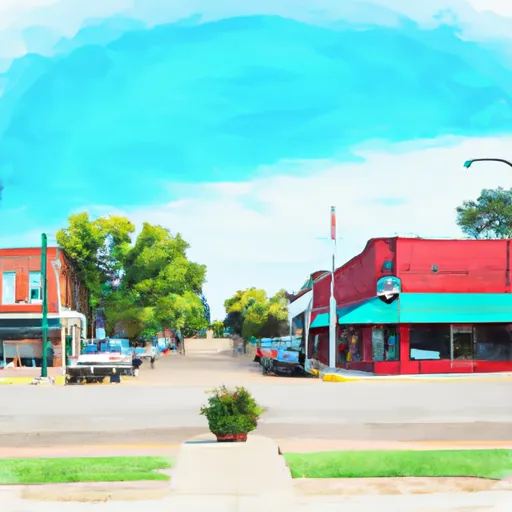-
 Snoflo Premium
Snoflo Premium
Get unlimited access to all our content
With no Ad interruptions! - Start Your Free Trial Login with existing account
Mission
Eden Index
Climate
8.3
•
Recreation
3.1
•
Community
3.9
•
Safeguard
5.4/10

Mission, Kansas, located in Johnson County, is a charming suburb with a population of approximately 9,500 residents. The city experiences a humid continental climate, characterized by hot summers and cold winters. Summers are warm with average temperatures ranging from the mid-80s to low 90s Fahrenheit, while winters can be cold with temperatures averaging in the mid-30s to low 40s.
Hydrologically, Mission lies within the Kansas River basin, with the Turkey Creek passing through the city. The area is relatively flat, with some gentle slopes and occasional floodplains along the creek. The Turkey Creek is important for stormwater drainage and contributes to the overall hydrology of the region.
Mission offers several outdoor recreation opportunities for residents and visitors. The city boasts well-maintained parks and green spaces, including the popular Johnson Drive Park and Shawnee Mission Park nearby. These parks provide opportunities for activities such as walking, jogging, picnicking, and even fishing in some designated areas. Additionally, Mission is part of the extensive Johnson County parks and trail system, making it easy to explore the surrounding nature and enjoy hiking, biking, and other outdoor activities.
What is the Eden Index?
The Snoflo Eden Index serves as a comprehensive rating system for regions, evaluating their desirability through a holistic assessment of climate health, outdoor recreation opportunities, and natural disaster risk, acknowledging the profound impact of these factors on livability and well-being.
Climate Health Indicator (CHI): 8.3
Mission receives approximately
990mm of rain per year,
with humidity levels near 81%
and air temperatures averaging around
13°C.
Mission has a plant hardyness factor of
6, meaning
plants and agriculture in this region thrive during a short period during spring and early summer. Most
plants will die off during the colder winter months.
By considering the ideal temperature range, reliable water supplies, clean air, and stable seasonal rain or snowpacks, the Climate Health Indicator (CHI) underscores the significance of a healthy climate as the foundation for quality living.
A healthy climate is paramount for ensuring a high quality of life and livability in a region, fostering both physical well-being and environmental harmony. This can be characterized by ideal temperatures, reliable access to water supplies, clean air, and consistent seasonal rain or snowpacks.
Weather Forecast
Streamflow Conditions
Lower Missouri-Blackwater
Area Rivers
Lower Missouri-Blackwater
Snowpack Depths
Lower Missouri-Blackwater
Reservoir Storage Capacity
Lower Missouri-Blackwater
Groundwater Levels
Recreational Opportunity Index (ROI): 3.1
The Recreational Opportunity Index (ROI) recognizes the value of outdoor recreational options, such as parks, hiking trails, camping sites, and fishing spots, while acknowledging that climate plays a pivotal role in ensuring the comfort and consistency of these experiences.
Access to outdoor recreational opportunities, encompassing activities such as parks, hiking, camping, and fishing, is crucial for overall well-being, and the climate plays a pivotal role in enabling and enhancing these experiences, ensuring that individuals can engage in nature-based activities comfortably and consistently.
Camping Areas
| Campground | Campsites | Reservations | Toilets | Showers | Elevation |
|---|---|---|---|---|---|
| Linn County Park | 113 | 856 ft | |||
| Lanagan Access City Park | None | 851 ft | |||
| Longview Lake County Campground | 113 | 931 ft | |||
| Baxter Springs Riverside Park | None | 783 ft | |||
| Schifferdecker Park | None | 1,026 ft | |||
| Twin Bridges State Rec Area | None | 825 ft | |||
| Honey Creek State Park | None | 812 ft | |||
| Lake Miola City Park | 35 | 910 ft | |||
| Louisburg Middle Creek State Fishing Lake | None | 990 ft | |||
| Twin Bridges State Park | None | 815 ft |
Nearby Fishing
Catastrophe Safeguard Index (CSI):
The Catastrophe Safeguard Index (CSI) recognizes that natural disaster risk, encompassing floods, fires, hurricanes, and tornadoes, can drastically affect safety and the overall appeal of an area.
The level of natural disaster risk in a region significantly affects safety and the overall livability, with climate change amplifying these risks by potentially increasing the frequency and intensity of events like floods, fires, hurricanes, and tornadoes, thereby posing substantial challenges to community resilience and well-being.
Community Resilience Indicator (CRI): 3.9
The Community Resilience Indicator (CRI) recognizes that education, healthcare, and socioeconomics are crucial to the well-being of a region. The CRI acknowledges the profound impact of these elements on residents' overall quality of life. By evaluating educational resources, healthcare accessibility, and economic inclusivity, the index captures the essential aspects that contribute to a thriving community, fostering resident satisfaction, equity, and social cohesion.

